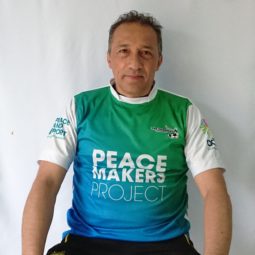The story of COP (Constructors of Peace) Colombia started when my son, Gerson Florez, became the spokeperson of children affected by antipersonnel mines. He was then internationally recognized for its advocacy role. After more than 50 years of internal armed conflict, the Colombian Victims Unit estimates that more than 2.500.000 children have been affected by violence.
In 1998, the President of Colombia, Ernesto Samper, invited Gerson to the inauguration of the National Peace Council as a representative of the children. He worked towards The Hague Appeal for Peace Conference in 1998, where he spoke about the war in the name of Colombian children, and he won the Youth Prize for Peace and Tolerance in 1999. In 2002, he was nominated by the Belgian Ambassador in Colombia to the King Baudouin Prize and to the Nobel Peace Prize.
During a trip to Norway, Gerson met the President of the Norwegian Football Federation and discovered the Norway Cup; an international youth football tournament held in Oslo. He realized that soccer can be a powerful tool for social work, and it became evident to him that social sports programs can foster a culture of peace and reconciliation from the field of play.
It was thanks to Gerson’s commitment and experiences that we decided to create and establish COP Colombia International in Usme, a strategic corridor to Bogota impacted by the actions of the FARC guerrilla. The situation of vulnerability and the lack of opportunities for the youth has led to an increased risk of recruitment into armed groups, to the formation of youth gangs, and to micro-trafficking. Presently, young people are highly exposed to the risks of school dropout, drug addiction, early pregnancy and prostitution. As we believe that sport can be an escapism to violence, we use soccer as a unifying tool to teach values and to help girls and boys to solve problems peacefully.
In our first project, in 2009, young people who belonged to “barras bravas” (hooligans) were part of the “Let’s go to the Cup” program. Their experience abroad, in Norway, generated a reflection on tolerance and the value of life. Today, the beneficiaries are adults with a very different approach: they are still supportersbut do not support the team aggressively and refrain from assaulting opponents or supporters of the opponent team. Opportunities such as international sports exchanges and the chance to gain a higher education changed their aggressive behavior in exchange for a vision of overcoming and achieving positive goals, together.
One of our beneficiaries, Wilson Silva, managed to be chosen as one of the two winners in Colombia of The Chance, a contest organized by Nike, that took him to La Masia, in Barcelona. Despite growing up in a difficult family environment, he gained confidence and discipline through the practice of soccer. Wilson received a scholarship from COP Colombia and he obtained his translation degree. Today, he teaches English in a prestigious school in Bogota and he has worked on the Spanish translation of the Peace and Sport by MyCoach mobile application.
The story of COP Colombia and the story of our beneficiaries demonstrates that global efforts towards the achievement of the sustainable development goals will not be achieved without peace education programs and the meaningful participation of the youth. In the aftermath of a conflict, such as Colombia’s conflict, peace oriented education and sport activities are essential to foster resilience and help young people to manage conflicts in a non-violent manner.
